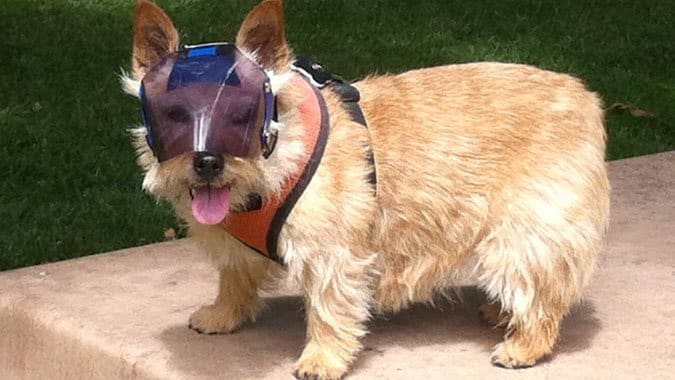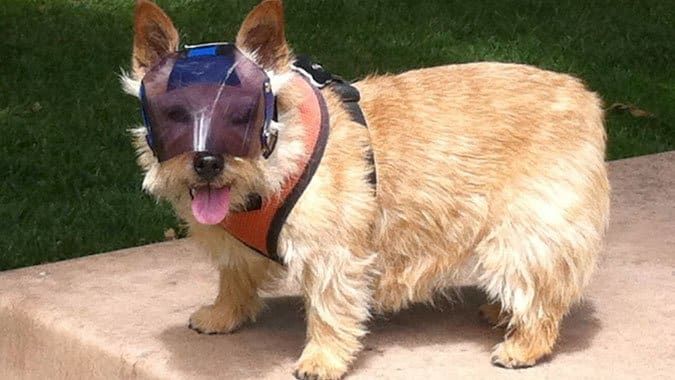Long-time WDJ contributor Mary Straus has been dealing with a health issue with her senior Norwich Terrier, Ella. She came up with a solution that I hadn’t seen before, and I asked her if she could provide us with more information; it may help some of you with your dogs! Here is what she wrote:
My Ella is now 12 years old, and starting to have trouble with the glare of the sun. I had her checked by an ophthalmologist to be sure nothing was wrong, and she confirmed it’s just age-related changes, and that her iris can’t contract as well as it used to, making it harder for her to see in bright light. I asked about Doggles, and the vet agreed that protecting her eyes from the sun was a good idea, but said most dogs hate wearing the Doggles because they’re heavy and block their peripheral vision. She suggested an Optivizor from Protective Pet Solutions instead.
After some work to figure out the correct size, Ella is now happily wearing her new Optivizor on walks. She appears comfortable wearing it, has no trouble seeing or investigating all the interesting smells while wearing it, and may even appreciate its help with the sun’s glare.

I actually used an Optivizor in 2008 on my previous dog following eye surgery, as it was far more comfortable than a cone, and it worked really well. Since then, they have improved the design and lowered the cost!
Ella is wearing the Mini (Regular Snout) size. The Short-Snout version didn’t fit her face (too close to her eyes), and the Toy size was too big for her head, though it might work for a larger Norwich (Ella weighs just under 11 lbs). The only problem with the Mini size is that if her eyebrows are grown out, the visor pushes them down over her eyes, but it works well when she’s groomed properly.
Some of my friends on Facebook have asked me questions about the Optivizor.
Q: How did you determine the glare was difficult for her?
A: She started flinching strongly when walking from bright light into shadow. Since it was a change in behavior, and because flinching can be a sign of PRA, I had her checked by the ophthalmologist just to be safe. She found just normal age-related changes, including iris muscle atrophy that she said was causing the problem seeing in bright light.
Q: I’m going to check out the visor as my youngest pug has 2 good eyes and I’m trying to keep them that way, and Doggles don’t work on his weird pug head.
A: The company makes a special version of the Optivizor for short-snouted dogs that should work well on a Pug.
Q: Do they make a nose protector for Collie nose? My Collie has lupus. I can’t find one.
A: The visor is long enough to cover the nose. Both the clear and the tinted versions offer UV protection. See the photos of Holly, the greyhound mix, on this page: https://www.protectivepetsolutions.com/optivizor—apply-and-fit.html
Q: Great! Can also protect the eyes against the wind too when cycling
A: I’m not sure how it would work for wind – if the dog lifts its head, the visor would catch the wind, with unpredictable results. I think you need something that fits close to the face, like Doggles, for that.







We observed the same things about our 14 year old dog’s flinching. We now have him wear a goggle for dogs (which we bought for when he rides the bicycle with us) and it seems to lessen the flinching. Glad to get some form of validation with this article. I only wish we could do more.